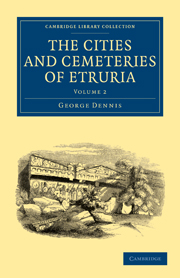Book contents
- Frontmatter
- Contents
- List Of Illustrations In Volume II
- CHAPTER XXX CIVITA VECCHIA—CENTUM CELLÆ.
- CHAPTER XXXI SANTA MARINELLA—PUNICUM
- CHAPTER XXXII SANTA SEVERA.—PYRGI
- CHAPTER XXXIII CERVETRI—AGYLLA OR CÆRE.
- CHAPTER XXXIV PALO—ALSIUM
- CHAPTER XXXV LUNI—LUNA
- CHAPTER XXXVI PISA.—PISÆ.
- CHAPTER XXXVII FIRENZE.—FLORENTIA
- CHAPTER XXXVIII FIESOLE.—FÆSULÆ
- CHAPTER XXXIX SIENA—SENA.
- CHAPTER XL VOLTERRA.—VOLATERRÆ
- CHAPTER XLI VOLTERRA.—VOLATERRÆ
- CHAPTER XLII THE MAREMMA
- CHAPTER XLIII POPULONIA—POPULONIA
- CHAPTER XLIV ROSELLE—RUSELLÆ
- CHAPTER XLV TELAMONE—TELAMON
- CHAPTER XLVI ORBETELLO
- CHAPTER XLVII ANSEDONIA—COSA
- CHAPTER XLVIII VETULONIA
- CHAPTER XLIX SATURNIA—SATURNIA
- CHAPTER L CHIUSI—CLUSIUM
- CHAPTER LI CHIUSI—CLUSIUM
- CHAPTER LII CHIUSI—CLUSIUM
- CHAPTER LIII CETONA AND SARTEANO
- CHAPTER LIV CHIANCIANO AND MONTEPULCIANO
- CHAPTER LV AREZZO—ARRETIUM
- CHAPTER LVI CORTONA—CORTONA
- CHAPTER LVII PERUGIA—PERUSIA
- CHAPTER LVIII PERUGIA—PERUSIA
- CHAPTER LIX ROME
- Index
- ERRATA IN VOL. II.
- Maps
CHAPTER XXX - CIVITA VECCHIA—CENTUM CELLÆ.
Published online by Cambridge University Press: 05 July 2011
- Frontmatter
- Contents
- List Of Illustrations In Volume II
- CHAPTER XXX CIVITA VECCHIA—CENTUM CELLÆ.
- CHAPTER XXXI SANTA MARINELLA—PUNICUM
- CHAPTER XXXII SANTA SEVERA.—PYRGI
- CHAPTER XXXIII CERVETRI—AGYLLA OR CÆRE.
- CHAPTER XXXIV PALO—ALSIUM
- CHAPTER XXXV LUNI—LUNA
- CHAPTER XXXVI PISA.—PISÆ.
- CHAPTER XXXVII FIRENZE.—FLORENTIA
- CHAPTER XXXVIII FIESOLE.—FÆSULÆ
- CHAPTER XXXIX SIENA—SENA.
- CHAPTER XL VOLTERRA.—VOLATERRÆ
- CHAPTER XLI VOLTERRA.—VOLATERRÆ
- CHAPTER XLII THE MAREMMA
- CHAPTER XLIII POPULONIA—POPULONIA
- CHAPTER XLIV ROSELLE—RUSELLÆ
- CHAPTER XLV TELAMONE—TELAMON
- CHAPTER XLVI ORBETELLO
- CHAPTER XLVII ANSEDONIA—COSA
- CHAPTER XLVIII VETULONIA
- CHAPTER XLIX SATURNIA—SATURNIA
- CHAPTER L CHIUSI—CLUSIUM
- CHAPTER LI CHIUSI—CLUSIUM
- CHAPTER LII CHIUSI—CLUSIUM
- CHAPTER LIII CETONA AND SARTEANO
- CHAPTER LIV CHIANCIANO AND MONTEPULCIANO
- CHAPTER LV AREZZO—ARRETIUM
- CHAPTER LVI CORTONA—CORTONA
- CHAPTER LVII PERUGIA—PERUSIA
- CHAPTER LVIII PERUGIA—PERUSIA
- CHAPTER LIX ROME
- Index
- ERRATA IN VOL. II.
- Maps
Summary
Ad Centumcellas forti deflexinius Austro;
Tranquillâ puppes in statione sedent.
Molibus æquoreum concluditur amphitheatrum,
Angustosque aditus insula facta tegit;
Attollit geminas turres, bifidoque meatu,
Faucibus arctatis pandit utrumque latus.
Nee posuisse satis laxo navalia portu,
Ne vaga vel tutas ventilet aura rates.
Interior medias sinus invitatus in ædes
Instabilem fixis aëra nescit aquis.
Rutilius.Whoever has approached the Eternal City from the sea must admit the fidelity of the above picture. As Civita Vecchia was 1400 years since, so is it now. The artificial island, with its twin-towers at the mouth of the port; the long moles stretching out to meet it; the double passage, narrowed almost to a closing of the jaws; the amphitheatre of water within, overhung by the houses of the town, and sheltered from every wind—will be at once recognised. It would seem to have remained in statu quo ever since it was built by Trajan. Yet the original town was almost utterly destroyed by the Saracens in the ninth century ; but when rebuilt, the disposition of the port was preserved, by raising the moles, quay, and fortress on the ancient foundations, which are still visible beneath them.
It is possible, in ancient times, when the ruler of the world made it his chosen retreat, and adorned it with his own virtues and the simple graces of his court, that Centum Cellæ may have been, as Pliny found it, “a right pleasant place” —locus perjucundus.
- Type
- Chapter
- Information
- The Cities and Cemeteries of Etruria , pp. 1 - 4Publisher: Cambridge University PressPrint publication year: 2010First published in: 1848



